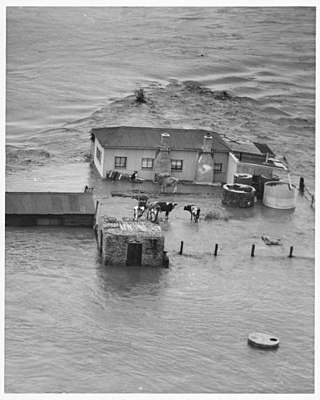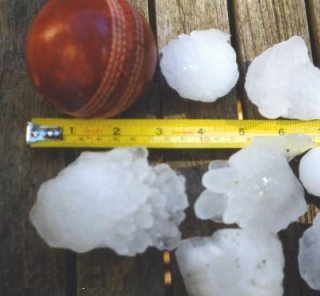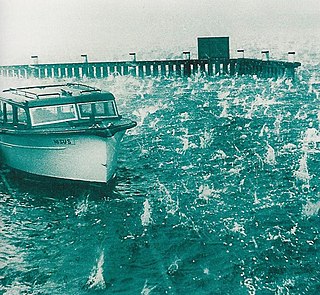
Meteorology is a branch of the atmospheric sciences with a major focus on weather forecasting. The study of meteorology dates back millennia, though significant progress in meteorology did not begin until the 18th century. The 19th century saw modest progress in the field after weather observation networks were formed across broad regions. Prior attempts at prediction of weather depended on historical data. It was not until after the elucidation of the laws of physics, and more particularly in the latter half of the 20th century, the development of the computer that significant breakthroughs in weather forecasting were achieved. An important branch of weather forecasting is marine weather forecasting as it relates to maritime and coastal safety, in which weather effects also include atmospheric interactions with large bodies of water.

The Weather Prediction Center (WPC), located in College Park, Maryland, is one of nine service centers under the umbrella of the National Centers for Environmental Prediction (NCEP), a part of the National Weather Service (NWS), which in turn is part of the National Oceanic and Atmospheric Administration (NOAA) of the U.S. Government. Until March 5, 2013 the Weather Prediction Center was known as the Hydrometeorological Prediction Center (HPC). The Weather Prediction Center serves as a center for quantitative precipitation forecasting, medium range forecasting, and the interpretation of numerical weather prediction computer models.

A weather presenter is a person who presents the weather forecast daily on radio, television or internet news broadcasts.
The Bureau of Meteorology is an executive agency of the Australian Government responsible for providing weather services to Australia and surrounding areas. It was established in 1906 under the Meteorology Act, and brought together the state meteorological services that existed before then. The states officially transferred their weather recording responsibilities to the Bureau of Meteorology on 1 January 1908.
The 1967 Tasmanian fires were an Australian natural disaster which occurred on 7 February 1967, an event which came to be known as the Black Tuesday bushfires. They were the most deadly bushfires that Tasmania has ever experienced, leaving 64 people dead, 900 injured and over seven thousand homeless.

The Hunter Valley Floods of 23 February 1955 was a major flood on the Hunter River in New South Wales, Australia. They were one of the most devastating natural disasters in Australia's history.

Severe storms in Australia refers to the storms, including cyclones, which have caused severe damage in Australia.

The Royal Netherlands Meteorological Institute is the Dutch national weather forecasting service, which has its headquarters in De Bilt, in the province of Utrecht, central Netherlands.

Sky News Weather Channel is an Australian satellite television channel owned by Australian News Channel, a subsidiary of News Corp Australia. Launched on 1 January 1999, the channel broadcasts weather forecasts and weather-related news and analysis 24 hours a day.

Drought in Australia is defined by the Australian Bureau of Meteorology as rainfall over period greater than three-months being in the lowest decile of what has been recorded for that region in the past. This definition takes into account that drought is a relative term and rainfall deficiencies need to be compared to typical rainfall patterns including seasonal variations. Specifically, drought in Australia is defined in relation to a rainfall deficiency of pastoral leases and is determined by decile analysis applied to a certain area. Note that this definition uses rainfall only because long-term records are widely available across most of Australia. However, it does not take into account other variables that might be important for establishing surface water balance, such as evaporation and condensation.

The 1893 Brisbane flood, occasionally referred to as the Great Flood of 1893 or the Black February flood, occurred in 1893 in Brisbane, Queensland, Australia. The Brisbane River burst its banks on three occasions in February 1893. It was the occurrence of three major floods in the same month that saw the period named "Black February". There was also a fourth flood later in the same year in June. The river runs through the centre of Brisbane with much of the population living in areas beside the river. It first flooded on February 6 due to a deluge associated with a tropical cyclone, called "Buninyong".

The 1999 Sydney hailstorm was the costliest natural disaster in Australian insurance history, causing extensive damage along the east coast of New South Wales. The storm developed south of Sydney on the afternoon of Wednesday, 14 April 1999, and struck the city's eastern suburbs, including the central business district, later that evening.
A series of destructive severe thunderstorms struck southeastern Queensland, Australia, on 29 November 1992. The storms produced strong winds, flash flooding and large hailstones in the region, including the capital city of Brisbane. The storms also spawned two of the most powerful tornadoes recorded in Australia, including the only Australian tornado to be given an official 'F4' classification on the Fujita scale and the last violent tornado in Australia until 21 March 2013.

The 1947 Sydney hailstorm was a natural disaster which struck Sydney, Australia, on 1 January 1947. The storm cell developed on the morning of New Year's Day, a public holiday in Australia, over the Blue Mountains, hitting the city and dissipating east of Bondi in the mid-afternoon. At the time, it was the most severe storm to strike the city since recorded observations began in 1792.

Irving P. Krick was an American meteorologist and inventor, the founding professor of Department of Meteorology at California Institute of Technology (1933–1948), one of the U.S. Air Force meteorologists who provided forecasts for the Normandy Landings in 1944, a controversial pioneer of long-term forecasting and cloud seeding, and "a brilliant American salesman" who in 1938 started the first private weather business in the United States.
The most deadly floods on record in Tasmania's history occurred in April 1929 when 22 people were killed and 40 injured.

The 2000s drought in Australia, also known as the millennium drought is said by some to be the worst drought recorded since European settlement.
Australian rivers have been subject to devastating floods in New South Wales, recorded since colonisation. Flooding in New South Wales has predominately been caused by excessive flows into rivers located in New South Wales and, to a lesser extent, excessive flows into rivers located in Queensland and Victoria. Floods can devastate local communities and impact the entire local economy.

Australian east coast lows are extratropical cyclones or low-pressure systems on the coast of southeastern Australia that may be caused by both mid-latitude and tropical influences over a variety of levels in the atmosphere.
Josh Holt is an Australian TV meteorologist who works at Network 10.













